 Image search results - "kusatsu" Image search results - "kusatsu" |

The Kusatsu Shukuba Matsuri Festival is held on April 29 to celebrate Kusatsu's history as a post town on the Nakasendo and Tokaido Roads. Numerous events and activities are held such as flea markets, street & stage performances, and Japanese danThis was the first time I saw hula dancing in Shiga. Surprised to see hula dancing (Kusatsu Station plaza).
|
|
|

The Kusatsu-juku Honjin is decorated with curtains. MAP
|
|

Shukuba Odori dance in the shopping arcade.Held 11:00 - 12:00
|
|

Start of Kusatsu Jidai Gyoretsu Procession 草津時代行列
|
|
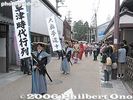
Kusatsu Shukuba Matsuri is held on April 29 to celebrate Kusatsu's history as a stage town on the Nakasendo and Tokaido Roads. The main highlight is this Kusatsu Jidai Gyoretsu procession from 11:45 am to 2 pm. This is the Tokaido Road.
|
|

Kusatsu Shukuba Festival, Shiga Pref. 大奥夢道中
|
|

Kusatsu Shukuba Festival, Shiga Pref.
|
|
|
|

Kusatsu-juku was the fifty-second station on the Tokaido Road (following Ishibe-juku) and the sixty-eighth station (following Moriyama-juku) on the Nakasendo Road. During the Edo Period, Kusatsu was an important post town at the crossroads of both roads.The roof is shaped like a Honjin lodge, with a gate. 草津駅
|
|
|
|
|
|
|
|

JR Kusatsu Station in spring.
|
|
|
|
|

JR Kusatsu Station iwith azaleas.
|
|
|
|
|
|

JR Kusatsu Station
|
|

Probably the highest ranking lady.
|
|
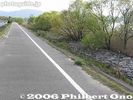
Bicycling road on the "Sazanami Kaido" lakeshore road going south.
|
|

Kusatsu Shukuba Festival, Shiga Pref.
|
|
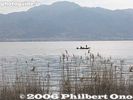
View of Lake Biwa from the lakeshore road.
|
|
|
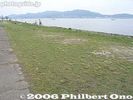
Lake Biwa shore. Lots of picnicking space.
|
|
|
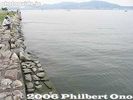
Fishing too
|
|
|
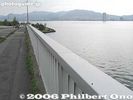
Bridge to Yabase
|
|
|
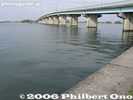
Bridge to Yabase
|
|
|
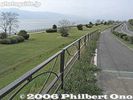
Yabase lakeshore park 矢橋帰帆島
|
|

Hiroshige's woodblock print of Boats Returning to Yabase from his "Omi Hakkei" (Eight Views of Omi) series.
|
|

Hiroshige's woodblock print of Boats Returning to Yabase from his "Omi Hakkei" (Eight Views of Omi) series.
|
|

Edo Period Buddhist nun
|
|
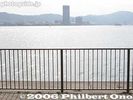
Otsu Prince Hotel right across the lake.
|
|
|
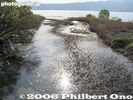
River mouth
|
|

Children's procession 子供奴道中
|
|
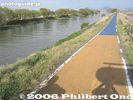
River and cycling path
|
|

Kusatsu town map. Kusatsu basically developed along the old Nakasendo and Tokaido Roads as they intersected before going on to Kyoto, Shiga's neighboring prefecture.
|
|

Daimyo Gyoretsu (Feudal Lord) procession 大名行列
|
|
|
|
|
|
|
|
|
|
|
|
|

Kusatsu River
|
|
|
|
|
|
|
|

Professional actor from the Toei Eiga-mura movie village.東映太秦映画村の役者
|
|
|
|
|
|

Palanquin かご
|
|

Oiwake Guidepost road marker at the intersection of the Tokaido and Nakasendo Roads. The left side says "Left for Nakasendo Road" and the right side says "Right for Tokaido Road."
|
|
|
|
|
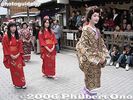
Kusatsu Shukuba Festival, Shiga Pref.
|
|
|
|
|

Kusatsu Shukuba Festival, Shiga Pref.
|
|
|
|
|
|

Kusatsu Shukuba Festival, Shiga Pref.
|
|

Road marker at the intersection of the Tokaido and Nakasendo RoadsThis tunnel goes under the Kusatsu River.
|
|
|

Lord's crest
|
|
|
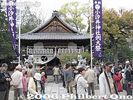
1:00 pm: Rest stop at Oshioi Shrine. 小汐井神社
|
|
|

The women only leave the shrine for their own procession.
|
|

Serving free sake.
|
|
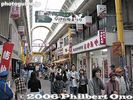
Shopping mall
|
|
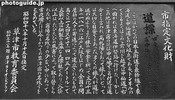
Road marker plaque
|
|

Hiroshige's woodblock print of Kusatsu-juku (69th post town on the Nakasendo) from his Kisokaido series.
|
|
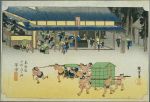
Hiroshige's woodblock print of Kusatsu-juku (53rd post town on the Tokaido) from his "Fifty-Three Stations of the Tokaido Road" series. A rest house and servants are depicted.
|
|

Kusatsu historyBeing a stage town along the Tokaido Road connecting Edo (Tokyo) and Kyoto, Kusatsu had over 70 inns for travelers. The best inn was the Honjin, reserved for daimyo warlords, Imperial family members, etc.
|
|

Kusatsu-juku Honjin on the Tokaido Road. MAP
|
|

Kusatsu-juku Honjin. the Honjin was the town's most luxurious accommodation catering to society's elite like daimyo warlords, Imperial family members including the emperor, and other dignitaries. National Historic SiteAt stage towns along the major roads like the Nakasendo and Tokaido, the Honjin was the town's most luxurious accommodation catering to society's elite like daimyo warlords, Imperial family members including the emperor, and other dignitaries. It operated during 1635 to 1870. The Honjin is now a museum.
This Honjin in Kusatsu is a very impressive example of traditional architecture. It is designated as a National Historical Place. It underwent a complete renovation and reconstruction during 1989 to 1995. (In case you wonder why such an old building looks so new.) Admission 200 yen. 10-min. walk from Kusatsu Station.
|
|

Kusatsu-juku Honjin entrance. This Honjin in Kusatsu is a very impressive example of traditional architecture. It is designated as a National Historical Place. It underwent a complete renovation and reconstruction during 1989 to 1995. Admission 200 yen.
|
|

Genkan Hiroma entrance hall straight ahead. It was the entrance for daimyo feudal lords. 玄関広間
|
|
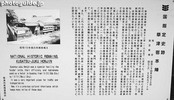
About the Kusatsu-juku Honjin
|
|

Sekifuda name plates in Genkan Hiroma entrance hall. This is what you see when you enter the Honjin through the Genkan Hiroma entrance hall. The name plate for the warlord staying at the lodge was displayed. 玄関広間This is what you see when you enter the Honjin through the Genkan Hiroma entrance hall. The name plate for the warlord staying at the lodge was displayed here.
|
|

Kusatsu-juku Honjin corridor. Pass by numerous Japanese-style rooms. 畳廊下畳廊下
|
|

Kusatsu-juku Honjin guest book. See the names of Kira and Lord Asano both of whom once lodged at this Honjin (at different times). These two men later became adversaries which led to the legendary chushingura or vendetta of the 47 masterless samurai. 大�You can see the names of Kira and Lord Asano both of whom once lodged at this Honjin (at different times). These two men later became adversaries which led to the legendary chushingura or vendetta of the 47 masterless samurai.
大福帳
|
|

Jodan no Ma: Kusatsu-juku Honjin's best room in the house. Reserved for daimyo warlords, emperors, etc. 上段の間
|
|

Jodan no Ma - Kusatsu-juku Honjin's best room in the house. Reserved for daimyo warlords, emperors, etc. 上段の間
|
|

Jodan no Ma - Kusatsu-juku Honjin. The Gyokuza raised tatami mats was where the lord or Emperor slept or sat. 上段の間Reserved for daimyo warlords, emperors, etc.
|
|

Jodan no Ma - Kusatsu-juku Honjin's best room in the houseReserved for daimyo warlords, emperors, etc. The room had an elevated tatami mat for the person to sit and sleep on.
上段の間
|
|
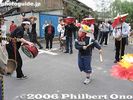
Practicing for the local sanyare festival. The Kusatsu Sanyare dance has been inscribed as a UNESCO Intangible Cultural Heritage in 2022 as one of Japan's furyu-odori (風流踊) ritual dances.
|
|

Mukae Jodan no Ma 向上段の間向上段の間
|
|

Mukae Jodan no Ma. Painting on the fusuma sliding doors by Matsumura Keibun. 向上段の間
|
|

Urinal (made of lacquered wood) for warlords. The room has two tatami mats. Right below the urinal is a bamboo mat. Above is a small shoji paper window to provide light.
|
|

Toilet (made of lacquered wood) for warlords. This is a separate room adjacent to the urinal. It also has two tatami mats. The walls are plain and not decorated. The toilet had a box which was likely replaced each time it was used. 上段雪隠This is a separate room adjacent to the urinal. It also has two tatami mats. The walls are plain and not decorated. The toilet had a box which was likely replaced each time it was used.
Jodan settin
上段雪隠
|
|

Marker for Emperor Meiji's visit and outdoor garden
|
|

Outdoor garden
|
|
|

Yudono bath room for warlords. The hot water was heated nearby and carried to this room. 湯殿
|
|

Bath for feudal lordsLooks kind of small to me.
湯殿
|
|

Kitchen (Daidokoro doma). Dirt-floored room with wood-heated stoves. High ceiling with no chimney, but the ceiling has a covered opening. 台所土間
|
|

Honjin owner Tanaka's house
|
|

Honjin owner Tanaka's house
|
|

Honjin owner's house
|
|

Ceiling
|
|

Kusatsu-juku Kaido Koryu-kan is a history museum with various exhibits showing Kusatsu's post town history. Admission 200 yen. You can buy a set ticket good for both the Honjin and this history museum. 草津街道交流館
|
|

Kusatsu-juku Kaido Koryu-kan. Terminals are provided to find information about Kusatsu. 草津街道交流館 MAP
|
|

Kusatsu-juku Kaido Koryu-kan 草津街道交流館
|
|

Kusatsu-juku Kaido Koryu-kan. Sample food from the old days, dinner on left and breakfast on right. 草津街道交流館
|
|

Photo op room at Kusatsu-juku Kaido Koryu-kan. You can dress up as a traveler on the Tokaido/Nakasendo Road and take a picture of yourself. You can even sit in the palanquin. A tripod is provided too. 草津街道交流館
|
|

Palanquin at Kusatsu-juku Kaido Koryu-kan 草津街道交流館For photos.
|
|

Ukiyoe prints of Kusatsu-juku at Kusatsu-juku Kaido Koryu-kan 草津街道交流館
|
|

Kusatsu-juku Kaido Koryu-kan草津街道交流館
|
|

Model of the town at the Kusatsu-juku Kaido Koryu-kan 草津街道交流館
|
|

Waki Honjin souvenir shop and restaurant脇本陣
|
|
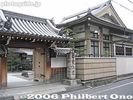
Temple with road marker
|
|

Closeup of road marker indicating the Tokaido Road to the right and Nakasendo to the left.
|
|

Tabi-maru. a traveler character from Kusatsu, Shiga. Kusatsu was a crossroads on the old Tokaido and Nakasendo Roads where many travelers lodged. "Tabi" means "travel." たび丸 (滋賀 草津市)
|
|
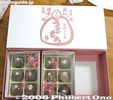
Ubaga Mochi, famous Kusatsu confection.
|
|

Kusatsu as seen from Mt. Hiei
|
|
|
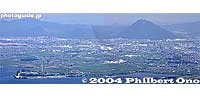
Kusatsu as seen from Mt. HieiKarasuma Peninsula is also visible.
|
|

Lake Biwa Museum has a world-class freshwater aquarium showing Lake Biwa's endemic species and more. Open 9:30 am - 5 pm, closed Mon. and the day after a national holiday. Admission 600 yen for adults.It shows Lake Biwa's history, fish and wildlife, coexistence with people, and a large lake-fish aquarium. It is also a research facility with a number of researchers and curators.
|
|

Main entrance. Open 9:30 am - 5 pm, closed Mon. and the day after a national holiday. MAPNote that the museum underwent major renovations and reopened in July 2016. Some of the old exhibits have been replaced and there are also new exhibits like Lake Baikal seals.
|
|

Take a bus from JR Kusatsu Station. Admission 750 yen for adults. MAP
|
|

The photos in this album are video stills taken from my Lake Biwa Museum video.
|
|

Entrance hall atrium
|
|

My comprehensive video about Lake Biwa's endemic species and invasive species displayed at the Lake Biwa Museum's freshwater aquarium.
|
|

About Lake Biwa
|
|

Lake Biwa's North Basin.
|
|

View from Mt. Hiei Driveway.
|
|

Lake Biwa's South Basin.
|
|

Lake Biwa Museum's freshwater aquarium displays fish species endemic to Lake Biwa, found no where else.
|
|

Definitions of endemic, native, endangered, and invasive species.Native species (在来種)
Naturally inhabits Lake Biwa or Shiga and not introduced by man. May also inhabit places outside Shiga.
Endemic species (固有種・亜種)
Native species found only in Lake Biwa or Shiga.
Endangered species (絶滅危惧種)
Those facing a high risk of extinction in the wild.
Invasive species (侵略的外来種)
Introduced by man and harms the native species, environment, and local ecosystem.
|
|

Fish in Reed Beds & Attached Lakes 内湖・ヨシ原にすむ魚 - Reeds are a haven for carps (wataka, ginbuna), bitterlings, gudgeons, and mussels. Invasive species (black bass, bluegill) dominate such habitats today.
|
|
|
|

Wataka (ワタカ) Ischikauia steenackeri - Endangered endemic species, herbivorous fish.
|
|

Mussel
|
|

Reeds are essential
|
|

Aquarium tunnel showing rocky habitat.
|
|
|

Nigorobuna carp (ニゴロブナ 似五郎鮒) - Endangered endemic species, famous for funazushi.
|
|

Gengorobuna carp (ゲンゴロウブナ) - Endangered endemic species
|
|

Lake Biwa Giant Catfish is shy and often hides in its shelter.
|
|

On another day, we were able to see the two Lake Biwa Giant Catfish out in the open. It is nocturnal, and this tank simulates night time while the aquarium is open during the day. The lake's largest endemic species and Japan's largest catfish. �
|
|

Lake Biwa Giant Catfish is the lake's largest endemic species (max. 1.2 meter long), dubbed the King of Lake Biwa.
|
|

The tank simulates night time since the Lake Biwa Giant Catfish is nocturnal.
|
|

Albino Lake Biwa Giant Catfish
|
|

Ko-Ayu (コアユ) Native species, popular food fish. Ko-ayu is the small variety of ayu (not baby ayu) commonly eaten as tsukudani (佃煮) or tempura. Adult ko-ayu retain their small size.
|
|

Tempura ko-ayu sweetfish do not grow as large as the ayu sweetfish which grow big in rivers. Ko-ayu remain in the lake and feed on plankton. Such an environment prevents them from getting larger.
|
|

Biwa trout (ビワマス) - Endangered endemic species
|
|

Biwa trout/salmon - Endemic to Lake Biwa and lives in deep, cold (15˚C), pelagic waters. These are juvenile fish. Delicious!
|
|

Lake Biwa Littoral Zone 琵琶湖の岸辺の生き物 - Many small organisms live amid aquatic plants near the shore.
|
|

Numa-ebi shrimp (ヌマエビ), Native species
|
|

Sugo-Moroko gudgeon (スゴモロコ) - Endangered endemic species
|
|

Biwa-kogata-sujishima spiny loach (ビワコガタスジシマドジョウ) - Endangered endemic species
|
|

Biwa-Yoshinobori goby (ビワヨシノボリ) - Endemic species
|
|

Donko sleeper (ドンコ) - Native species endemic to Japan.
|
|

Hon-moroko (honmoroko) gudgeon (ホンモロコ) - Endangered endemic species, but it has been recovering in numbers during the 2020s.
|
|

Utsusemi-kajika sculpin (ウツセミカジカ) - Endangered endemic species
|
|

Utsusemi-kajika sculpin (ウツセミカジカ) - Endangered endemic species
|
|

Abura-higai gudgeon (アブラヒガイ) - Endangered endemic species
|
|

Biwa-higai gudgeon (ビワヒガイ) - Endemic species
|
|

Fish with Unusual Traits 面白い習性の魚 - Gigi talking catfish.
|
|

"Gigi" talking catfish (ギギ) Pelteobagrus nudiceps - Native species
|
|

Tanago bitterling and clam (タナゴ) - Endangered native species, endemic to Japan, lays eggs in living clams.
|
|

Ginbuna carp (ギンブナ) - Native species, reproduces without males.
|
|

Invasive Species 外国からきた魚 - The aquarium has a number of tanks showing invasive species like this Red-eared slider/terrapin (ミシシッピアカミミガメ).Invasive species, popular pet, outcompetes native turtles for physical space.
|
|

Northern snakehead (カムルチー) - Invasive species, eats aquatic insects, mollusks, and carp.
|
|

Red swamp crayfish (アメリカザリガニ) - Invasive species, destroys water plants, outcompetes others for food.
|
|

Black bass (Largemouth bass) are the worst invasive species in Lake Biwa. (ブラックバス・オオクチバス)
|
|

Black bass, an invasive species in Lake Biwa which eats the babies of native fish. If you catch one of these, you must not throw it back into the lake. Dispose of it.
|
|

Largemouth bass (black bass) and bluegill are Lake Biwa's worst invasive species. They eat eggs and fry of native fish, crustaceans, and insects.
|
|

Bluegill was brought to Japan in 1960 as a food fish by then Crown Prince Akihito who received it as a gift from Chicago, IL. In 1963, the Fisheries Agency sent bluegill to Lake Biwa. Ten years later, bluegill had spread all over the lake. In 2007 in Shiga, Emperor Akihito expressed regret over bringing the bluegill.
|
|

Around the lake are disposal bins for invasive fish. Do not throw invasive fish back into the lake.
|
|

Koi or Nishiki-goi (錦鯉) - Ornamental common carp.
|
|

Midstream River Fish 川の中流の生き物 - Pale chub and dark chub with streamlined bodies suited for river currents. At bottom are pike gudgeon.
|
|

Dark chub (カワムツ) - Native species
|
|

Upstream River Fish 川の上流の生き物 - Fish favoring cold water such as char and red-spotted masu salmon.
|
|

Red-spotted masu salmon - Endangered native species (サツキマス・アマゴ)
|
|

Japanese stream toad (ナガレヒキガエル) - Native species, endemic to Japan.
|
|

Water Birds 水辺の鳥 Little Grebe (カイツブリ) - Native species, Shiga's official bird (県の鳥).In classic literature like Tale of Genji, Lake Biwa is called, "Lake of Little Grebes" (Nionoumi).
|
|
|

Tundra swans and bean geese winter on Lake Biwa.
|
|

Hariyo three-spined stickleback - Endangered native species (ハリヨ)
|
|

Fish Conservation and Breeding Center 保護・増殖センター - They breed endangered freshwater fish species and research breeding methods.
|
|

Lake Fish from Other Countries 世界の湖の魚たち - Chinese high fin banded shark (エンツュイ) from Lake Dongting, China.
|
|

Iridescent shark (カイヤン) from Tonlé Sap Lake, Cambodia.
|
|

Tinfoil barb (シルバーバルブ) from Tonlé Sap Lake, Cambodia
|
|

Electric catfish (デンキナマズ) from Lake Tanganyika, Africa
|
|

Lake trout (レイクトラウト) from The Great Lakes, North America
|
|

Ancient Fish 古代魚 Sturgeon (チョウザメ) and gar have changed little over millions of years. They are called living fossils. Ancient fish feeding time is 3:40 pm. Sturgeon use their barbel whiskers to feel the bottom for food. They have no teeth.
|
|

Sturgeon is also famous for caviar.
|
|

Sturgeon are ancient fish
|
|

Feeding time for sturgeon.
|
|
|
|

Sturgeon feeding
|
|
|

Touching Corner ふれあい体験室 - Petting zoo for crayfish and small fish.
|
|
|
|

Lake Biwa and the Lakes of the World
|
|

USA (Great Lakes)
|
|

Area in front of Lake Biwa Museum.
|
|

Other exhibition rooms
|
|

Geological History of Lake Biwa - Exhibition Gallery A 琵琶湖のおいたち(A展示室)
|
|

Seventeen million years ago, southeastern Shiga was under a warm ocean. Fossils of dolphins and this baleen whale bone (replica) have been found in Tsuchiyama, Koka.
|
|

Replica of a Stegodon elephant skeleton similar to the Mie elephant that roamed along the shores of Lake Biwa's forerunner lake 3.5 to 4 million years ago.
|
|

Two million years ago, the Mie elephant had become extinct and this smaller Akebono elephant lived in Shiga until it became extinct 1 million years ago. Mie elephants roamed a subtropical lake land 3 to 4 million years ago.
|
|
|

Mie elephants once roamed this area.
|
|

Lake Biwa's forerunner Lake Oyamada emerged about 4 million years ago southeast of Shiga in Iga, Mie Prefecture. Over millions of years, at least two lakes formed and disappeared before Lake Katata (western Otsu) formed.
|
|

This lake got larger and deeper as geological protuberances 400,000 years ago pushed it to where Lake Biwa is today. South Basin on the left is much shallower than the North Basin.
|
|
|

Display of endemic fish and other species found only in Lake Biwa.
|
|

Lake Biwa's endemic species. The lake's long history and diverse habitats (rocky areas, sandy beaches, attached lakes, reeds, cold waters, pelagic zones) gave rise to these 17 endemic fish and 30 mollusk species.
|
|

Endemic mussel used to produce Biwa pearls, now extinct.
|
|

People and Lake Biwa - Exhibition Gallery B 人と琵琶湖の歴史(B展示室)
|
|

Humans appeared around Lake Biwa about 9,000 years ago, mainly along the South Basin. They ate nuts, lake fish and shellfish, and wild animals.
|
|

Awazu Shell Mound of food waste from 4,500 years ago excavated in 1990-91 near Seta River. 粟津貝塚
|
|

The shells are mostly endemic Seta shijimi clams.
|
|

Seta-no-Karahashi Bridge on the old Tokaido Road over the Seta River in Otsu. It was the eastern gateway to Kyoto. 瀬田の唐橋
|
|

Underwater foundation of the Seta-no-Karahashi Bridge from the 7th century. Discovered in 1988 about 80 meters downstream from the present bridge.
|
|

Maruko-bune, a traditional wooden boat mainly for shipping cargo across Lake Biwa in the old days. 丸子船
|
|

Maruko-bune were a vital transportation link between northern Japan and Kyoto/Osaka. Goods coming and going via the Sea of Japan also went over the lake.
|
|

Most of the wood is Japanese conifer (槇の木).
|
|

The cargo was mainly rice, fish, and kelp.
|
|

The bow's tip is studded.
|
|

Checkered pattern was unique to Lake Biwa boats.
|
|

Black copper plates decorate the bow (ダテカスガイ). The wood seams are stuffed with conifer fiber (槙縄) to repel water.
|
|

Maruko-bune's trademark is this half-round cedar or cypress log on both sides. おも木
|
|

The boat's bottom is flat, suited for shallow waters.
|
|

At 19 meters long, 2.4 meters wide, and 12 meters high.
|
|

The sail is made of thick cotton material, replacing the old straw mat that didn't last long.
|
|

Rudder hangs down from a torii-like brace (かさ木), also used as a mast rest when the mast is laid down.
|
|

The museum's maruko-bune was built by Shiga's last maruko-bune builder, Matsui Sanshiro (松井三四郎) and his son in 1995 in Seta, Otsu.
|
|

Born in 1913, Mr. Matsui built several maruko-bune until the 1930s. The completed boat sailed to the museum.
|
|

Maruko-bune transported rice, fish, kelp, and many other northern Japan goods bound for Kyoto/Osaka. From Kyoto, came cotton, confections, soy sauce, sake, kimono, textiles, tobacco, and more.
|
|

Hari-bune, a traditional fishing boat mainly for longline fishing (延縄). There is no half-round log on the side, so it is not a maruko-bune. ハリブネ
|
|
|
|
|